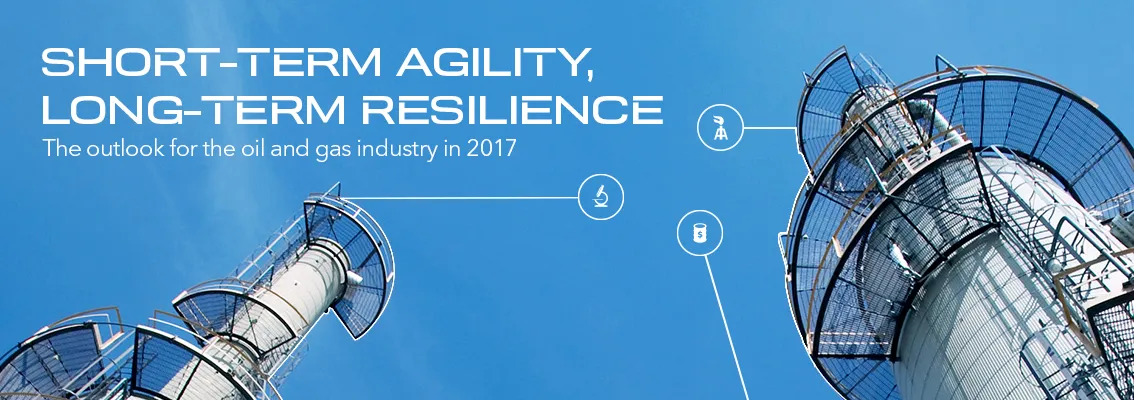New research by DNV GL, the technical advisor to the oil and gas industry, reveals that confidence in oil and gas sector growth in China in 2017 has fallen sharply from 61% last year to 23% - lower than global opinion (32%). Chinese respondents are also less confident about their organization’s prospects, profits and revenue. However, the research also shows that Chinese companies are rebalancing business portfolios and reorganizing for a new era where gas will be an important part of the energy mix.
The research by DNV GL reveals signs of deep, strategic changes for sustainable growth in China, beyond the sector’s usual cyclical patterns. More than half (55%) expect their companies to diversify into, or invest more in, opportunities outside of oil and gas – a larger share than globally (49%). 42% expect their business to invest (or increase investment) in renewable energy in 2017. Three in five of those surveyed believe most industry investments in renewable energy mark a shift in long-term business strategy. Chinese respondents say that strategic re-orientation will be their most important measure for cutting costs (47%).
Short-term agility, long-term resilience is DNV GL’s seventh annual benchmark study on the outlook for the oil and gas industry providing a snapshot of industry confidence, priorities and concerns for the year ahead. It draws on a survey of 723 senior sector players1.
Yi Wolfgang Wu, Regional Business Development Manager, DNV GL - Oil & Gas, Greater China, Korea & Japan, says: “The drop in oil prices and the weakness of the market are now being felt strongly across the sector as shown by a drop in all measures of confidence. However, the sector is taking action through technological innovation, operational optimization, organizational restructuring, and rebalancing business portfolios to secure long-term sustainable growth. With increasing emphasis on environmental protection, natural gas is expected to be an increasingly important part of the energy mix and renewable energy investments signal a more robust, diverse and sustainable energy future.”
A vast majority (84%) of Chinese respondents expect gas to play an increasingly important role in the energy mix over the next 10 years. Notably, 45% stated that their organization is actively looking for new M&A opportunities in the gas sector as a result of falling oil prices.
Further, cost management is still seen as a high priority among Chinese respondents, and has increased from 75% last year to 87% in 2017. There has also been a significant increase in those expecting headcount reductions up from 27% in 2016 to 63% in 2017. Concerningly, more than a third (35%) believe that cost cutting initiatives in their organization are increasing health and safety risk, compared to 19% globally.
However, cost pressures are also driving some more positive cost control measures. Nearly three in five respondents (58%) agreed that cost pressures were driving more industry collaboration. Digitalization is also increasingly seen as a means to enhance cost and operational efficiencies.
Digitalization will be a focus for R&D efforts with a much higher proportion of Chinese respondents than globally (74% versus 49%) agreeing that their business needs to embrace digitalization to increase profitability.
“The effects of the downturn are now being strongly felt in China and it is concerning to see that this may be negatively affecting HSE levels in China. We as a sector should never compromise on safety,” Wolfgang Wu says. “Like the rest of the global oil and gas industry, the key to surviving and thriving is the ability to adapt and embrace digitalization, standardization and the benefits of collaboration. This will enable the industry to transform to meet the demands of the new era and become profitable in volatile markets.”
Other key findings include:
- Nearly two thirds (63%) of those questioned disagree that the worst of the industry downturn is over, compared to 42% globally.
- The focus on asset efficiency has increased significantly since last year, up from 39% to 52%.
- 61% of respondents in China believe operators will increasingly push to standardize their delivery globally.
- Respondents in China expect increased focus on emissions control (37% versus 16% globally) and reducing environmental impact in 2017 (35% versus 17%).
- The development of subsea technologies is highest on the R&D agenda in China by 32% of respondents. At 29%, re-use of offshore infrastructure for renewable application is second, closely followed by digitalization, FLNG and cold climate (all 26%).
- 42% stated that efforts to implement digitalization had increased since the downturn in 2014, close to the global figure of 39%. An out-dated culture is seen as the biggest barrier to digitalization in China by 39% of those surveyed, compared to 30% globally.
1. The outlook for the oil and gas industry in 2017 is an industry benchmark study from DNV GL, the leading technical advisor to the industry. Now in its seventh year, the programme builds on the findings of six prior annual outlook reports, first launched in early 2011. During October and November 2016, we surveyed 723 senior professionals and executives across the global oil and gas industry, along with 14 in-depth interviews with a range of experts, business leaders and analysts. Two–thirds (66%) are employed by suppliers and service companies across the industry, while 26% of respondents work for oil and gas operators. The remaining respondents come from regulators and trade associations. The companies surveyed vary in size: 41% had annual revenue of USD500m or less, while 18% had annual revenue in excess of USD5bn. Respondents were drawn from right across the oil and gas value chain, including publicly-listed companies and privately-held firms. They also represent a range of functions within the industry, from board-level executives to senior engineers.
